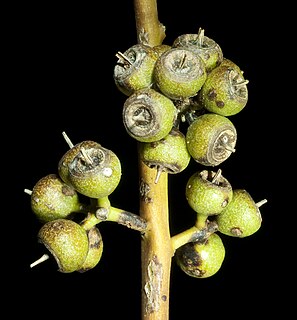Eucalyptus zopherophloia, commonly known as the blackbutt mallee, is a species of spreading mallee that is endemic to an area on the west coast of Western Australia. It has rough bark over part or all of the trunk, smooth grey bark above, narrow lance-shaped leaves, flower buds in groups of nine or eleven, creamy white flowers and conical fruit.

Eucalyptus capillosa, commonly known as wheatbelt wandoo, or mallee wandoo, is a species of tree or mallee that is endemic to Western Australia. It has smooth, grey bark, lance-shaped to elliptic adult leaves, spindle-shaped flower buds in groups of nine to thirteen, white flowers and barrel-shaped to cylindrical fruit.
Eucalyptus exigua is a species of mallee that is endemic to Western Australia. It has smooth, whitish bark, linear to narrow lance-shaped adult leaves, flower buds in groups of between seven and eleven, white flowers and short barrel-shaped to conical fruit.

Eucalyptus flavida, commonly known as yellow-flowered mallee, is a species of mallee that is endemic to Western Australia. It has smooth greyish bark, sometimes with rough, flaking brownish bark at the base, lance-shaped adult leaves, long, elongated, tapering flower buds in groups of nine or eleven, yellow flowers and cylindrical or barrel-shaped fruit.
Eucalyptus histophylla is a species of mallee or small tree that is endemic to southern Western Australia. It has smooth bark, often with ribbons of shed bark, linear to narrow lance-shaped adult leaves, flower buds arranged in groups in leaf axils, white flowers and cylindrical to barrel-shaped or conical fruit.
Eucalyptus incerata, commonly known as Mount Day mallee, is a species of mallee that is endemic to southern Western Australia. It has smooth bark, lance-shaped adult leaves, flower buds with a long, horn-shaped operculum and arranged in groups of seven, yellow flowers and barrel-shaped to cup-shaped fruit.

Eucalyptus latens, commonly known as narrow-leaved red mallee, is a species of mallee that is endemic to the south-west of Western Australia. It has smooth grey and coppery bark, linear to narrow lance-shaped adult leaves, flower buds in groups of seven to eleven or more, creamy white flowers and small barrel-shaped to shortened spherical fruit.
Eucalyptus litorea, commonly known as saline mallee, is a species of mallee that is endemic to a small area on the southern coast of Western Australia. It has hard, rough grey bark on the trunk, smooth grey bark above, lance-shaped adult leaves, flower buds in groups of seven, white flowers and cylindrical or barrel-shaped fruit.
Eucalyptus livida, commonly known as wandoo mallee, is a species of mallee or small tree that is endemic to Western Australia. It has smooth bark, lance-shaped adult leaves, flower buds in groups of eleven or more, creamy white flowers and barrel-shaped fruit.
Eucalyptus microschema is a species of small, shrubby mallee that is endemic to the southwest of Western Australia. It has smooth, silvery grey bark, linear adult leaves, flower buds in groups of nine or eleven, white flowers and short, barrel-shaped fruit. It is restricted to a small area near Newdegate.
Eucalyptus obesa, commonly known as the Ninety Mile Tank mallee, is a species of mallee that is endemic to Western Australia. It has smooth, greyish to pale brown bark, usually lance-shaped adult leaves, flower buds in groups of between eleven and fifteen, creamy white flowers and shortened spherical to hemispherical fruit.
Eucalyptus olivina is a species of mallee or a tree that is endemic to Western Australia. It has smooth greyish bark, linear to narrow lance-shaped adult leaves, flower buds in groups of seven or nine, creamy white flowers and short barrel-shaped to cup-shaped fruit.

Eucalyptus petrensis, commonly known as limestone mallee, straggly mallee or koodjat, is a species of straggly mallee that is endemic to Western Australia. It has mostly smooth bark, lance-shaped adult leaves, flower buds in groups of between seven and thirteen, creamy white flowers and more or less spherical fruit.

Eucalyptus phaenophylla, also known as common southern mallee, is a species of mallee that is endemic to Western Australia. It has smooth bark, linear to narrow lance-shaped or narrow elliptical adult leaves, flower buds in groups of up to thirteen, pale lemon-coloured flowers and barrel-shaped, cylindrical or conical fruit.
Eucalyptus repullulans, commonly known as chrysoprase mallee, is a species of mallee that is native to arid parts of Western Australia and the far north-west of South Australia. It has smooth bark, lance-shaped adult leaves, flower buds in groups of between seven and thirteen, cream-coloured flowers and cup-shaped, cylindrical or conical fruit.
Eucalyptus rigens, commonly known as saltlake mallee, is a species of sprawling mallee that is endemic to the southwest of Western Australia. It has smooth bark, lance-shaped adult leaves, flower buds in groups of three on a flattened peduncle and sessile, ribbed fruit.
Eucalyptus subangusta is a species of tree, mallee or mallet that is endemic to the southwest of Western Australia. It has smooth bark, narrow lance-shaped leaves, flower buds in groups of up to nineteen, white flowers and cup-shaped to barrel-shaped fruit.
Eucalyptus tenuis is a species of slender mallet that is endemic to the southwest of Western Australia. It has smooth bark, lance-shaped adult leaves, flower buds in groups of three, creamy white flowers and conical, cup-shaped or bell-shaped fruit.

Eucalyptus clivicola, commonly known as green mallet, is a species of eucalypt that is endemic to Western Australia. It has smooth bark, linear to lance-shaped adult leaves, flower buds in groups of between nine and thirteen, pale yellow flowers and barrel-shaped, conical or cylindrical fruit.

Eucalyptus diminuta, commonly known as the spring mallee, is a species of mallee that is endemic to south-west of Western Australia. It has smooth, silvery to greyish bark, sometimes with rough flaky bark near the base, lance-shaped adult leaves, pendulous, elongated flower buds arranged in groups of seven, creamy white flowers and cup-shaped to bell-shaped fruit.









